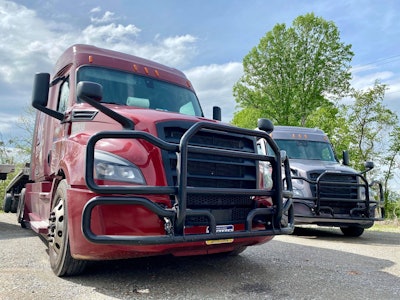
One of the most prevalent challenges faced by the trucking industry has always been safety and security; however, the nature of that challenge, as well as the options for response, have evolved over time. The most recent impact event on transportation safety and security is the Coronavirus disease (COVID-19) pandemic, as it has forced the industry to become less interactive, but still remain efficient.
It’s no secret that trucking safety has been a major concern throughout the industry in recent years. Fatal crashes involving large trucks steadily increased between 2014-2019. Through its Compliance, Safety, Accountability program, the Federal Motor Carrier Safety Administration (FMCSA) has worked to improve safety across the board and reduce the number of injury crashes and fatalities.
Although travel was down in 2020 due to the pandemic, fatalities on roadways jumped 7% year over year, according to the National Highway Traffic Safety Administration (NHTSA). However, preliminary estimates indicate fatal crashes involving large trucks were down marginally, and it appears that trucking safety technology may be a contributing factor.
The rapidly evolving proprietary technology industry has exploded in recent years, with a growing number of vendors rolling out new technology and software at a high clip. For example, trucking companies and their drivers were initially resistant to advanced driver assistance systems (ADAS), but recently the industry has come around. Overall, there is a significant trend towards the development of proprietary technology to meet logistics challenges.
One driver of proprietary technology development is the impact of the implementation of new processes from shippers and carriers, which have increased dwell times at shippers, causing delays and Hours of Service (HOS) issues. It is difficult for shippers and carriers to adapt and pivot to the new process if the infrastructure of their technology stack is not available.
The traditional solutions that carriers try to integrate with to help with the new process are contactless document systems, development of analytics on shipper profiles, updating safety suite systems or monitoring the process of shipper changes. New and innovative trucking safety technology has played an integral role in reducing crashes over the past decade through a mix of video recording, speed monitoring and predictive analytics. Technology can also inform safety procedures, reduce risk and potentially lower insurance rates.
For example, more and more trucking companies are beginning to use video to capture what's happening inside and outside the trucking rigs when accidents occur. The footage is helping them better understand what causes accidents, how truck drivers reacted and how the tractor trailer responded.
Flatbed carrier safety: what to look for in a provider
Technology, including automation and machine learning (ML), is a key driver of transportation safety and security, and there are several important elements tied to technology that suppliers should look for in their third-party logistics (3PL)/trucking providers when trying to meet today’s challenges. Data gathering and analytics should be a key part of the 3PL technology stack, as with the market and industry in a constant state of change, it is important to understand all aspects of the supply chain on an individual level. This helps predict issues in safety, security and operations before they happen.
Even a leading flatbed carrier capable of hauling freight may have blemishes in the safety department. A trucking company's size doesn't necessarily equate to its safety record, which is why it's important to look up publicly available inspection and crash data.
When evaluating a flatbed carrier from a safety standpoint, ask about trucking safety technology and advanced driver assistance systems. These systems assist drivers with braking, monitoring blindspots and even avoiding collisions. Does driver onboarding cover flatbed load securement best practices? Do they receive ongoing safety training? How much experience does the company's safety team have?
At the very least, look up the carrier's safety record on the FMCSA's website. The company snapshot will include the type of cargo carried, inspection/crash data and a safety rating, if applicable.
The future of trucking safety technology looks promising, with innovators racing to develop the next big thing.


















